|






We wish to express
gratitude to all of you, our unnamed friends, who have helped us creating this web pages.
Powered by Risjak
| |
The age of King Milutin, 14th
century
Serbian King Stefan Uros II Milutin (1282-1321) raised a new
church, dedicated to SS Joachim and Anne, latter to be generally known as the kings
church. The year of construction was September 1313 - August 1314
The entire reportoire of the old Byzantine architecture, revived
by the artistic movement and the end of the 13th century, fund its way into the mainstream
of Serbian architecture.
In the Byzantine fashion, the interior was notable for its
painted walls and costly details.
The Propeth Isaiah, fresco, 1313/1314, drum of the dome of the
King's church.
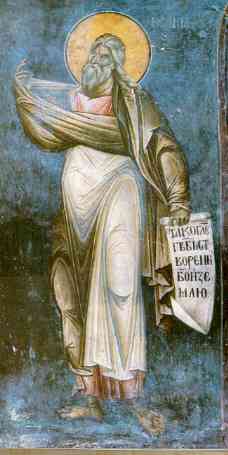
Ezekiel and Isaiah are on the east side, their scrolls recalling
the first vespers and matins by which the faithful are prepared for the feast of Eastern
Saturday, the day whose services explain Christ's sacrifice and resurrection.
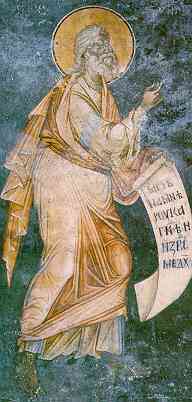
The Propher Ezekiel, fresco, 1313/14, drum of the dome of the
King's church
|
|
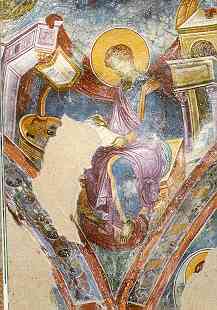 The Evangelist Luke, fresco, 1313/14, north-west pendentive of the King's
church
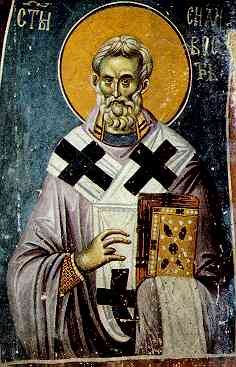
St Cyril of Alexandria, part of the fresco of Officiating
Bishops, 1313/14, altar area of the King's church
The Serbian People began to formulate their
spiritual identity during the are of the Holy Brothers Cytil and Methodius (9th
century), and their 5 disciples who followed (10th century). They are
considered the first baptizes and enlighteners of the Serbs, as well as the other Slavs.

St Clement of Ohrid, fresco, 1313/14, south window of the King's
church
The fruit of their work, harvested for some 2 centuries from
Byzantium/Bulgaria to the Adriatic, included the gradual Christianization of the Serbs
both nationally and individually, the appearance of the first ascetics and saints among
the Serbs, and the first monuments of Serbia's spiritual and secular cultures.

St John Chrysostom, part of the fresco of Officiating Bishops,
1313/14, altar area of the King's church
The preference for spiritual values became an inseparable part
of the Serbian national soul, as well as its lifeblood in the early stages of its history.
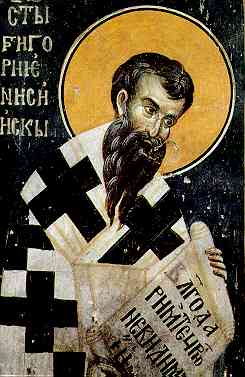
St Gregory of Nyssa, part of the fresco of Officiating
Bishops, 1313/14, altar area of the King's church
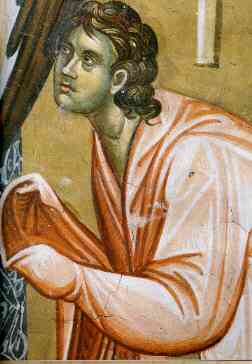
St John the Apostle, detail of the Apostle's Communion, fresco,
1313/14, apse of the King's church

Chist's Nativity, fresco, 1313/14, south wall of the nave,
King's church
In Christ's Nativity fresco, King Milutin's painters reveal
their preoccupation with lyrical liturgical poetry and learned metaphor. They conveyed the anxiety of the Virgin over
the fate of her son, whose end she foresees; she holds him tenderly, resting her cheek
against the child's head. This is not a realistic scene taken from life, but was inspired
by the sticheron (hymn) sung in the liturgy for December 28 (according to the Serbian and
Greek menaia).These verses interpret Christ's birth as a precondition for his sacrifice;
his humility and smallness is contrasted with his role as king of heaven, and his
deliberate acceptance of the form of Adam is shown as an aspect of the sacrifice which
brings salvation.

Adam and the Righterous, detail of the Harrowing of Hell,
fresco, 1313/14, north wall of the nave, King's church
|
|
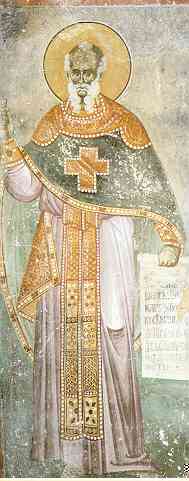 St. Theodore the Studite, painted beside the Dormition as the writer of a
homily devoted to this feast, fresco, 1313/14, north west pilaster of the nave, King's
church
|
|
|

















